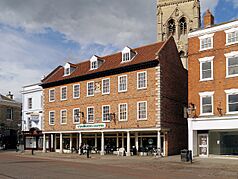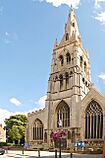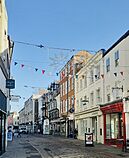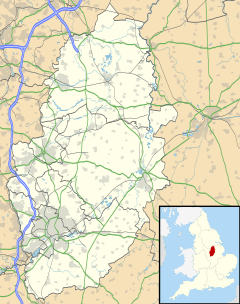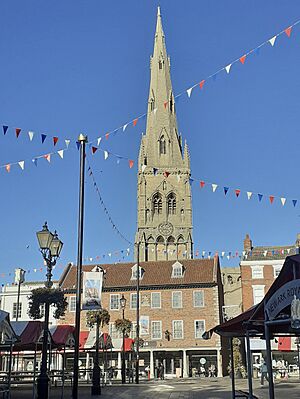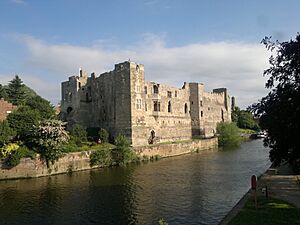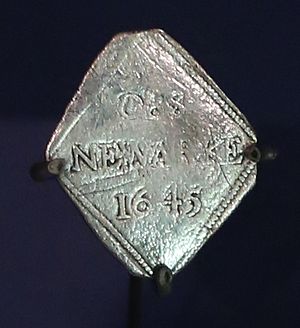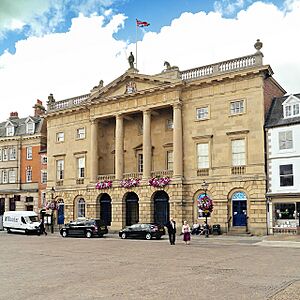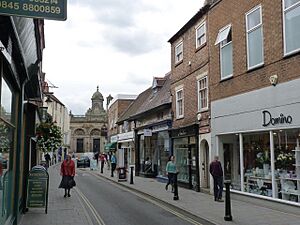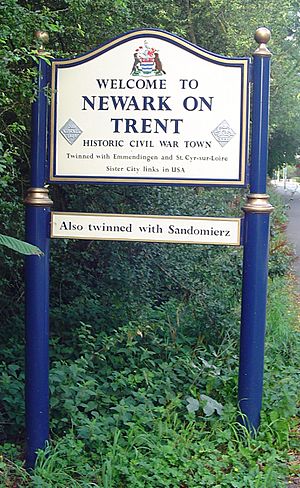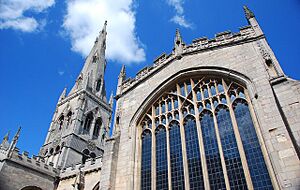Newark-on-Trent facts for kids
Quick facts for kids Newark-on-Trent |
|
|---|---|
| Town and civil parish | |
|
From the top, The former Moot Hall, Newark Castle, River Trent, St Mary Magdalene Church, Stodman Street Newark
|
|
Parish map |
|
| Area | 6.01 sq mi (15.6 km2) |
| Population | 30,345 (2021) |
| • Density | 5,049/sq mi (1,949/km2) |
| OS grid reference | SK 53745 61114 |
| • London | 140 mi (230 km) SSE |
| District |
|
| Shire county | |
| Region | |
| Country | England |
| Sovereign state | United Kingdom |
| Post town | Newark |
| Postcode district | NG22–NG24 |
| Dialling code | 01636 |
| Police | Nottinghamshire |
| Fire | Nottinghamshire |
| Ambulance | East Midlands |
| EU Parliament | East Midlands |
| UK Parliament |
|
Newark-on-Trent (pronounced like NEW-ark) or just Newark is a busy market town in Nottinghamshire, England. It sits right on the River Trent, which used to be a very important waterway for trade. The main A1 road goes around the town, following an old Roman road route.
Newark likely started as a Roman settlement because it's on the ancient Fosse Way road. The town grew up around Newark Castle and St Mary Magdalene Church. Later, it became famous for its wool and cloth trade.
During the English Civil War, Newark was a strong Royalist town. It was attacked three times but bravely defended. Today, Newark has a lovely marketplace with many old buildings. The St Mary Magdalene Church is a famous landmark. Its tall spire reaches 232 feet (71 metres) high, making it the tallest church in Nottinghamshire. In 2021, about 30,345 people lived in Newark.
Contents
- History of Newark
- Population of Newark
- Geography of Newark
- How Newark is Governed
- Education in Newark
- Newark's Economy
- Culture and Entertainment
- Famous Landmarks and Treasures
- Churches and Other Religious Sites
- Transport in Newark
- Media in Newark
- Notable People from Newark
- Twin Towns
- Images for kids
- See also
History of Newark
Early Times in Newark
The name "Newark" first appeared around 1054. It means "New fort" or "New work". This suggests it was a newly built fortified place.
The town's beginnings might be Roman. This is because it's located on the important Roman road called the Fosse Way. An old Anglo-Saxon burial ground from the 5th to 7th centuries was found near the River Trent. People buried ashes in pottery jars there.
Around 1055, Newark belonged to Godiva and her husband Leofric, Earl of Mercia. They gave it to Stow Minster. After the Norman Conquest, a Norman bishop took control. Later, the Bishops of Lincoln managed Newark until the time of King Edward VI.
From Medieval Times to the Stuart Era
Newark Castle began as a fortified house built by an Anglo-Saxon king. Around 1073, Bishop Remigius de Fécamp built a strong mound-and-fort castle there. A bridge over the river and St Leonard's Hospital were also built around this time. The bishop also got permission to hold a yearly fair and even make coins at the castle.
A very important event happened in 1216: King John died in Newark Castle.
Newark became a key place for the wool and cloth trade. By the time of Henry II, a big market was held there. Regular markets on Wednesdays and Saturdays started between 1156 and 1329. After King Henry III died, a mercenary refused to give Newark Castle back to the Bishop of Lincoln. This led to a siege by the French prince, which ended when the mercenary was paid to leave. By 1377, Newark was one of the 25 largest towns in England.
In 1457, a flood washed away the bridge over the Trent. The Bishop of Lincoln paid for a new bridge made of oak with stone towers. In 1571 or 1572, the composer Robert Parsons sadly drowned in the River Trent at Newark.
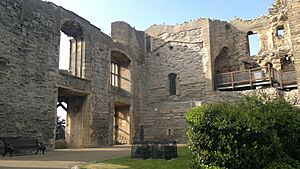
After England broke away from the Roman Catholic Church, King Henry VIII had the Vicar of Newark, Henry Lytherland, executed for not accepting the king as the head of the Church. In 1547, the King took ownership of the town from the Bishop of Lincoln. Newark became a proper town with its own leaders in 1549, and this was confirmed by Elizabeth I. Later, Charles I gave the town a new charter, allowing it to have a mayor and aldermen.
Newark During the English Civil War
During the English Civil War, Newark was a strong base for King Charles I's supporters, the Royalists. The town was attacked three times and only gave up when the King himself ordered it to. In February 1643, Newark fought off an attack by enemy horsemen. The town had up to 600 soldiers and often raided nearby towns.
In 1644, forces from Nottingham, Lincoln, and Derby attacked Newark. But Prince Rupert came and saved the town in March. Another siege began in January 1645, but it was also lifted a month later. Newark's soldiers fought with the King's army at the Battle of Naseby in June 1645, where the Royalists lost badly.
The final siege of Newark started in November 1645. By then, the town's defenses were very strong. Two large forts, the Queen's Sconce and the King's Sconce, were built near the river. There were also defensive walls and a water-filled ditch around the town. The King ordered Newark to surrender in May 1646, and the town's soldiers finally agreed. After this, most of the defenses were destroyed, including the Castle, which is why it looks ruined today. The Queen's Sconce was mostly left alone and its remains can still be seen in Sconce and Devon Park.
Georgian Era and Early 1800s
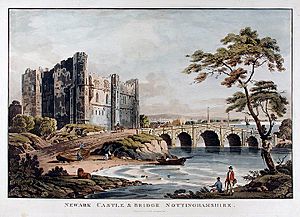
Around 1770, the Great North Road near Newark was raised on arches. This helped it stay clear during floods. In 1773, a special law allowed a new town hall to be built next to the Market Place. Newark Town Hall, designed by John Carr, was finished in 1776. It is now a very important historic building with a museum and art gallery. In 1775, the Duke of Newcastle built a new brick bridge near the Castle, which is still used today.
A printer named Daniel Holt (1766–1799) was important in Newark for wanting changes in government. He was even put in prison for printing leaflets about political reform.
In the early 1800s, the Duke of Newcastle removed many tenants from their homes in Newark. He did this because he thought they supported a different political candidate in the 1829 elections.
A schoolboy from Newark, J. S. Baxter, wrote about the "Hungry Forties." He described how people from Nottingham came to Newark with bread dipped in blood on sticks, shouting "Bread or blood!" This showed how tough life was for some people.
Newark in the 19th and 20th Centuries
Many new buildings and industries appeared in Newark during the Victorian era. These included churches, railway stations, a corn exchange, and factories. The Ossington Coffee Palace was built in 1882. It was a place where people could go instead of pubs, supporting the Temperance movement.
These changes and new industries caused Newark's population to grow a lot. It went from under 7,000 people in 1800 to over 15,000 by the end of the century.
During the Second World War, several RAF airfields were near Newark. Many Polish Air Force squadrons were based there. A special area in Newark Cemetery was set aside for RAF burials. This is now a war graves plot for Commonwealth and Polish soldiers. A memorial cross for the Polish airmen was put up in 1941. Two Polish presidents were buried there, though one was later moved back to Poland. RAF Winthorpe became the site of the Newark Air Museum.

In the last 100 years, Newark's main industries have included clothing, bearings, pumps, farm machinery, and making sugar. British Sugar still has a sugar-beet factory here. Many factories have closed since the 1950s, including some breweries. Since 1985, Newark has hosted the biggest antiques fair in Europe, the Newark International Antiques and Collectors Fair.
Population of Newark
In 2021, Newark had a population of 30,345 people. This was a 10% increase from the 27,700 people counted in 2011. The town forms a larger built-up area with nearby places, which had a population of 43,363 in 2011. In the 2011 census, about 77% of adults in Newark had jobs.
Geography of Newark
Newark is located about 21 miles (34 km) from Nottingham, 19 miles (31 km) from Lincoln, and 40 miles (64 km) from Leicester. All these cities are connected to Newark by the A46 road. The town is also near Mansfield (20 miles (32 km)), Grantham (14 miles (23 km)), and Southwell (9 miles (14 km)).
Newark sits on the River Trent, and the River Devon also flows through it. The town grew where the important Great North Road and the Fosse Way crossed. It developed around Newark Castle and a large market place.
Newark and the nearby area of Balderton form one continuous built-up area. To the south is Farndon, and to the north is Winthorpe.
Newark's growth was helped by having one of the few bridges over the River Trent. The river could also be used by boats, and the Great North Road (now the A1) passed through. Later, railways arrived, creating a junction between the East Coast Main Line and the Nottingham to Lincoln route. Newark became an important inland port, especially for the wool trade. It also developed industries like ironworks, engineering, brewing, and sugar refining.
The A1 bypass around Newark opened in 1964. A new section of the A46 road opened in 1990. In 2023, work began on a new road to connect the A46 to the A1 near Fernwood.
How Newark is Governed
Newark sends a Member of Parliament (MP) to the UK Parliament. William Ewart Gladstone, who later became Prime Minister, was Newark's MP several times in the 1830s and 1840s.
Newark has three levels of local government:
- Newark Town Council
- Newark and Sherwood District Council
- Nottinghamshire County Council
The District Council has 39 councillors who handle things like waste collection, planning, and leisure. It opened a national Civil War Centre and Newark Museum in 2015. The County Council has ten councillors from the area. They manage children's services, adult care, and roads.
Newark Town Council
The town has an elected council with 18 members from seven different areas. Newark Town Council looks after parks, open spaces, and Newark Market. It also organises events like festivals and runs a museum in the Town Hall. A new police station opened in Newark in 2006.
Education in Newark
Newark has three main mixed secondary schools. The oldest is Magnus Church of England Academy, founded in 1531. The Newark Academy is in nearby Balderton and was rebuilt in 2016. In 2020, the Suthers School opened as a new secondary school for Newark.
The town also has several primary schools, including a new one that opened in 2021.
Newark College is part of the Lincoln College, Lincolnshire Group. It has a special School of Musical Instrument Crafts, which opened in 1972. Here, students learn to make and repair guitars, violins, woodwind instruments, and pianos.
Newark's Economy
British Sugar runs a sugar-beet processing factory on the edge of town. It opened in 1921 and has about 130 full-time employees. The factory processes 1.6 million tonnes of sugar beet from about 800 UK farmers. It produces 250,000 tonnes of sugar for food and drink companies. The factory also has a power plant that makes electricity for the site and enough for 800 homes.
Other big employers in Newark include a bearings factory (part of the NSK group) and Laurens Patisseries, which makes pastries. Laurens Patisseries employs over 1,000 people. In 2007, Currys opened a large distribution center near the A17, employing over 1,400 staff during busy times. Flowserve, an engineering company, also has a factory in Newark.
Since 1985, Newark has been home to Europe's largest antiques fair, the Newark International Antiques and Collectors Fair. It happens every two months at the Newark Showground. Newark also has many antique shops.
Culture and Entertainment
Newark is home to Newark Rugby Union Football Club. Famous players like Dusty Hare have played for them. The town has a leisure centre that opened in 2016.
The Newark and Sherwood Concert Band has over 50 regular musicians and performs at many local events. The Royal Air Force Music Charitable Trust and Lincolnshire Chamber Orchestra are also based in Newark.
The Palace Theatre is Newark's main place for entertainment. It shows plays, live music, dance, and films.
The National Civil War Centre and Newark Museum opened in 2015. It teaches visitors about Newark's role in the English Civil War in the 1600s. In 2020, Newark was named one of the best places to live in the UK.
Famous Landmarks and Treasures

- The Market Place is the heart of the town. It has old pubs like The Queen's Head.
- The Church of St. Mary Magdalene is a very important historic building. Its tower and tall, eight-sided spire reach 236 feet (72 m) high. This makes it the tallest church spire in the county. It was carefully restored in the mid-1800s.
- Newark Castle was built by the river in 1123 by the Bishop of Lincoln. It used to make coins. Today, you can still see parts of the original Norman castle, like the gatehouse and a crypt. King John died here on October 18, 1216. During the English Civil War, it was a Royalist stronghold and faced three sieges. It was taken apart in 1646 after the King's side surrendered.
- The 16th-century Governor's House on Stodman Street is named after Sir Richard Willis, who was the Castle Governor during the Civil War. It's now a bakery and cafe and is a very important historic building.
Newark Torc
The Newark Torc is a special silver and gold Iron Age necklace. It was the first of its kind found in Nottinghamshire. It looks similar to treasures found in the Snettisham Hoard. It was discovered in 2005 and bought by Newark and Sherwood District Council in 2008. The torc was shown at the British Museum in London. Now, it is displayed in the galleries of the National Civil War Centre and Newark Museum.
Churches and Other Religious Sites
Newark has several churches. The main parish church is the historic St Mary Magdalene. Other Anglican churches include Christ Church and St Leonard's. The Catholic Holy Trinity Church was built in 1979. There are also three Methodist churches, a Baptist Church, and the Church of Promise.
In 2014, the Newark Odinist Temple was opened. It's a historic building and became the first modern Heathen temple in England.
Transport in Newark
Newark is a commuter town. Many people who live here travel to Lincoln, Nottingham, and even London for work.
Newark has two railway stations. Newark North Gate railway station is on the East Coast Main Line. You can get to London King's Cross in about 75 minutes. Trains also go north to Leeds, Hull, Newcastle upon Tyne, and Edinburgh Waverley. Newark Castle railway station is on the line that connects Leicester, Nottingham, and Lincoln. These two railway lines cross over each other at the last flat crossing in Britain.
The main roads around Newark are the A1 and A46 bypasses. The A17 goes east towards King's Lynn, and the A616 goes north towards Huddersfield.
The town has its own Newark bus station. Bus services are provided by companies like Stagecoach and Marshalls.
Media in Newark
Newark has a local weekly newspaper called the Newark Advertiser, which started in 1854. The same company also publishes newspapers for Southwell and Bingham.
You can listen to local radio stations like BBC Radio Nottingham and Capital Midlands. There's also a community radio station called Radio Newark on 107.8 FM, which started broadcasting in 2015.
Local news and TV shows come from BBC East Midlands and ITV Central.
Notable People from Newark
Famous in the Armed Forces
- Gonville Bromhead (1845–1891): An army officer who received the Victoria Cross medal. He went to Magnus Grammar School.
- John Cartwright (1740–1824): A naval officer and political reformer who studied in Newark.
Artists and Creatives
- William Caparne (1855–1940): A botanical artist born in Newark.
- William Nicholson (1872–1949): A painter and illustrator born in Newark.
Writers
- Matt Haig (born 1975): A well-known author and journalist who grew up in Newark.
- Henry Constable (1562–1613): A poet born in Newark.
Musicians
- John Blow (1649–1708): A famous composer and organist.
- Ian Burden (born 1957): Keyboard player for the band the Human League.
- Jay McGuiness (born 1990): A singer from the band The Wanted.
Sports Stars
- David Avanesyan (born 1988): A professional boxer.
- Dusty Hare (born 1952): A rugby union international player.
- Mary King (born 1961): An Olympic equestrian (horse riding) sportswoman.
- Chad Sugden (born 1994): A professional boxer born in Newark.
Actors and Performers
- Norman Pace (born 1953): An actor and comedian.
- Toby Kebbell (born 1982): An actor who went to The Grove School in Newark.
- Nathan Foad (born 1992): An actor and writer.
Twin Towns
Since 1984, Newark has been twinned with:
- Emmendingen, Germany
- Saint-Cyr-sur-Loire, France
- Sandomierz, Poland
Images for kids
See also
 In Spanish: Newark-on-Trent para niños
In Spanish: Newark-on-Trent para niños


